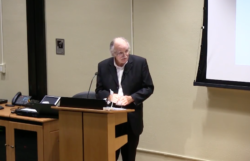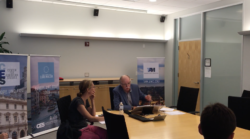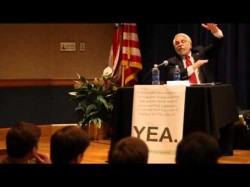Back to Basics on the Question of Labor
As we prepare to celebrate another Labor Day, we do well to remember that celebrating labor on just one day always runs the risk of implying that every other day is not a labor day. Celebratory days can invite tokenism as equally as they can generate empathy. Celebrating the fact of labor can so easily become a substitute for addressing its contemporary weakness, just as the day celebrating the life of Martin Luther King Jr. so often substitutes for a real conversation about the tenacity of racial inequality in today’s America.
It is striking just how regularly the weak bargaining power of the individual American worker is demonstrated – in data on wages, unemployment, poverty, inequality, and so on[1] – without that demonstration leading to any sustained public discussion about why labor is important and why the weakness of labor matters. It is striking too that many of those who will happily celebrate Labor Day this coming Monday will spend the rest of the week actively supporting policies designed to weaken labor: policies that include right-to-work legislation,[2] cuts in earned-income-tax credit, and limits on the scale and longevity of unemployment insurance.[3]
It is clearly better that we celebrate labor once each year than we never celebrate it at all. But better still would be a set of public policies designed to really honor labor by strengthening its institutions and increasing its rewards. To build a broad base of support for such policies requires more than data sets on unemployment and wages, vital as those are. It also requires the development and dissemination of arguments about why labor really matters, and why the current condition of American labor should offend us. Those arguments might include at least the following.
The importance of work in the modern economy
Work is not something we do occasionally, like playing video games or walking in the park. Work is something all of us do for a significant part of each and every day. It takes up most of our waking hours. Some of us work for wages. Some of us work unpaid, taking care of others. All of us do unpaid work in and around the home and family. Some of us want paid work but are unable to find it, or to find it in sufficient volume or proximity to make access to it easy. Some of us are unable to perform paid work even when it is readily available, and so must depend on the paid work of others – unable because we are too young or too old, too disabled or too sick. How a society organizes and rewards work is therefore a central and core element in its overall character. And since the availability of paid work, the monetary (and psychic) rewards linked to work, and the rights and responsibilities associated with work – both paid and unpaid – are all things we inherit from the past, they are also things which we can shape for the future. We mustn’t think about labor just once a year. We need to think about it, and its needs, all the time.
The unique features of labor markets and their needs
The United States, like most other industrialized countries, organizes paid work through labor markets. Firms buy the labor power of their employees, just as they buy the raw materials they process, and the equipment with which their employees transform those raw materials into products for sale. From the point of view of the average firm and its senior management, therefore, labor markets are just like any other market – the immediate logic of demand and supply operates in them all. But from the point of the individual employee, the market for labor and that for the products which they make are not the same. Inanimate objects can be molded this way and that, and sold or left un-bought on the shelf, without any wider social impact. But that is not true for people. Workers bring human capacities and concerns to work with them. The quality of their work is unavoidably affected by an agenda of issues that they necessarily bring with them to the work process – concerns about job security over time, concerns about fairness in rewards and duties, sensibilities to how they are treated by those around and above them, worries about family members and the quality of private time. And if those people are suddenly not employed, or if they are employed at rates of pay that are so low that they make normal life hard/impossible to finance, not only do they suffer. So too do all the others dependent upon them. Employment contracts may be private documents, individually signed, but they have powerful social consequences and so require rigorous and fair public regulation.
The imbalance of power between capital and labor
There is an underlying wage-effort bargain at the heart of a capitalist labor market. Normally firms seek to tip that bargain in favor of effort and away from wages, while their employees seek to shift the balance slightly in the other direction. I say “normally” because at the top of companies (particularly in the United States these days) the tipping seems to run the other way, with compensation packages inflated for senior people in order (so the claim runs) to both encourage and reward effort. But that boardroom largesse is not normally extended far down the employment hierarchy. There, employees are supervised for effort, and the link between effort and wages is widened as far as possible. Indeed, it is remarkable just how many of the vital work-roles on which we all rely (from childcare in the home to public health and safety provision outside it) are either not paid at all or paid very poorly. We should never assume that wages and usefulness go up together in an economy and society such as ours. If there is a general rule, it is that the relationship between them tends to go the other way. And that is partly because, when firms face individual workers, they do not do so on a level playing field. The wage that is so vital to the well-being of each individual employee is just a marginal cost to a firm employing many people. That firm can cut jobs to make itself marginally more profitable, but the jobs that are lost in that cutting mean – for each individual laid-off – a total life crisis. Unless individual workers at moments of unemployment have rights of access to resources provided from outside the firm – rights to unemployment benefits, severance pay, health care, even food stamps – their capacity individually or collectively to fight for better wages inside the firm is seriously impaired. This is presumably why corporate America currently spends so much money lobbying for the reduction/removal of those rights.
The lack of labor rights in the American economic model
That lobbying has been very successful lately. Labor rights, good wages and high degrees of job security are currently missing or under heavy corporate pressure in modern America. Income and wealth inequality between those at the bottom and top of companies is at a record level[4] – one in danger, in the President’s words, of “fraying the country’s social fabric.”[5] Wage stagnation for the bottom 70% of the U.S. labor force turned the years 2002-2012 into a lost decade for them.[6] Rights to organize trade unions to bring that growing inequality down by bringing wages up are increasingly blocked by anti-union legislation at the level of the states (the euphemistically labeled right-to-work laws[7]). The level of the minimum wage lags behind levels elsewhere,[8] and is lower now in real terms than it was in 1963.[9] Unemployment remains unacceptably high, with its actual rate obscured both by the degree of involuntary part-time employment, and by high levels of withdrawal from the labor market by the long-term unemployed. Poverty-level wages touch one family in three, and the United States “leads the industrial world in the percentage of jobs that are low-paid” – 25% here, 15% in Japan.[10] Rates of social mobility are now lower in America than in parts of Western Europe;[11] and the United States remains unique among major industrial economies in the absence here of a string of rights affecting women at work, not least the absence of paid maternity leave and rights to flexible working hours. In a generation, the United States has moved from being a high-wage/low-hours economy to being a low-wage/long-hours one; and that shift has occurred even though labor productivity has risen and corporate profits have flourished. It is a shift intimately connected to a co-ordinated employers’ offensive against trade unionism in Reaganite and post-Reagan America.[12]
The need for trade union power & progressive policies
This Labor Day will come hard on the heels of the 50th anniversary of the “I Have a Dream” Speech by Martin Luther King Jr., and we all have had an opportunity again to see how closely King associated civil rights with labor rights.[13] And well he might, for rights are empty things without the resources to enjoy them. It is too easy (and entirely misleading) for conservative voices to dismiss trade unions as corrupt and to blame the high wages unions demand for the unemployment now blighting so many potential trade union members. If we are genuinely concerned to locate and critique the causes of low pay and unemployment in contemporary America, it is not trade unions which should be the focus of our ire. For globally we are currently locked in a race to the bottom, wirh American wages in sector after sector being brought low by corporate outsourcing to cheaper labor markets abroad. Those falling wages are then coming back to bite the corporate bottom line, by eating away at the purchasing power of the workers they increasingly fail to pay well.[14] Soaring private debt – on houses and on credit cards – squared that circle for corporate America until the financial crisis of 2008. That trick will not be pulled off again. The need now is for the creation of a renewed race to the top both globally and at home: globally, by trade policies that discriminate in favor of commodities produced in economies paying decent wages and in which workers have the right to organize; and at home by the rolling back of right-to-work legislation, the strengthening of trade unionism,[15] and the building of a new set of worker rights that ease problems of unemployment and facilitate the combination of well-paid work with well-funded childcare.
Now the introduction of that policy mix would really make Labor Day something worth celebrating. So perhaps we should try it.
This argument is developed more fully in
Making the Progressive Case: Towards a Stronger U.S. Economy[16]
[1] See Robert Reich, Trimming for Labor Day, posted on The Huffington Post, August 26, 2013: available at http://www.huffingtonpost.com/robert-reich/minimum-wage-increase_b_3816534.html
[2] See Elise Gould and Heidi Shierholz, The Compensation Penalty of “Right-to-Work” Laws, EPI Briefing Paper, February 17, 2011: available at http://www.epi.org/publication/bp299/
[3] Evan Soltas, “The Untimely Death of Unemployment Insurance,” Bloomberg, August 28, 2013: available at http://www.bloomberg.com/news/2013-08-28/the-untimely-death-of-unemployment-insurance.html
[4] See Joseph Stiglitz, The Price of Inequality, posted at ProjectSyndicate, June 6, 2012: available at http://www.project-syndicate.org/commentary/the-price-of-inequality
[5] In an interview July 27, available at http://www.nytimes.com/2013/07/28/us/politics/interview-with-president-obama.html?pagewanted=all&_r=0
[6] The details are at http://www.epi.org/publication/a-decade-of-flat-wages-the-key-barrier-to-shared-prosperity-and-a-rising-middle-class/
[7] See Steven Wishnia, The Most Dishonest Words in American Politics: ‘Right to Work,’ posted on Alternet.org, June 8, 2013: available at http://www.alternet.org/labor/right-work-unions-collective-bargaining
[8] See Dylan Matthews, ‘The U.S. has a $7.25 minimum wage, Australia’s is $16.88,” The Washington Post, August 19, 2013: available at http://www.washingtonpost.com/blogs/wonkblog/wp/2013/08/19/the-u-s-has-a-7-25-minimum-wage-australias-is-16-88/
[9] See Richard Eskow, A Dream Deferred: The Minimum Wage Was Higher in 1963 Than It Is Today, posted on The Huffington Post, August 26, 2013: available at http://www.huffingtonpost.com/rj-eskow/a-dream-deferred-the-mini_b_3820416.html
[10] See Harold Meyerson, “For retailers, low wages aren’t working out,” The Washington Post, August 20, 2013: available at http://articles.washingtonpost.com/2013-08-20/opinions/41428989_1_u-s-economy-wage-retailers
[11] See David Madland and Nick Bunker, Unions Boost Economic Mobility in U.S. States, Washington D.C.: Center for American Progress, September 20, 2012: available at http://www.americanprogressaction.org/wp-content/uploads/2012/09/MadlandBunkerUnions-2.pdf
[12] See Harold Meyeron, “What Happens if Labor Dies?” The Nation, November 29, 2012: available at http://prospect.org/article/if-labor-dies-whats-next
[13] Thomas Geoghegan, “King was Really a Labor Leader, Too,” Bloomberg, August 28, 2013: available at http://www.bloomberg.com/news/2013-08-28/king-was-really-a-labor-leader-too.html
[14] See Neil Shah, “Stagnant Wages Crimping Economic Growth,” The Wall Street Journal, August 26, 2013: available at http://online.wsj.com/article/SB10001424127887323980604579028822725730720.html
[15] See Kris Warner, “The Real Reason for the Decline of American Unions,” Bloomberg, January 24, 2013: available at http://www.bloomberg.com/news/2013-01-23/the-real-reason-for-the-decline-of-american-unions.html
Tags: childcare, I Have a Dream, income inequality, labor, Martin Luther King Jr., maternity leave, organized labor, poverty, trade unions, unemployment, unpaid work, wages, work
David Coates holds the Worrell Chair in Anglo-American Studies at Wake Forest University. He is the author of Answering Back: Liberal Responses to Conservative Arguments, New York: Continuum Books, 2010.
He writes here in a personal capacity.





